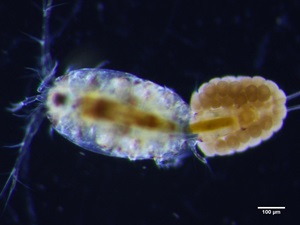Tiny animals swimming around in the water – in a size range of 0.2 to 2 mm – form a crucial link in the aquatic food web. They are summarized under the term mesozooplankton, and the most popular group amongst it are the copepods.
Made in Plankton - a new research programme at the DHI-NTU Research Centre in Singapore - now aims at using selected mesozooplankton species to forecast eventual threats to Singapore’s aquatic ecosystems, such as harmful algal blooms or bio-invasions.

It is essential to know which organisms are present, in which abundance and biomass and to understand how they interact with each other in the ecosystem (the so-called functional biodiversity) in order to develop proper management and forecasting tools. Therefore, we will 1) review all the available literature related to zooplanktonic species occurring around Singapore, 2) select representative sampling sites in different habitats and perform a rigorous monitoring program to create a biodiversity baseline for zooplankton, 3) understand the interaction between the trophic levels in the ecosystem, and 4) develop genetic probes for selected species as indicators to 5) forecast threats to Singapore’s waters.
Mesozooplankton species are our focus of attention: They are interlinked with various levels of the foodweb, as on the one hand they prey on phytoplankton – the primary producers at the base of the food web -, and on the other hand on smaller zooplankton organisms (microzooplankton), which itself feeds on phytoplankton again.
So far, our surveys have already had an unexpected outcome: during regular monitoring of the organism diversity at the DHI Ballast Water Centre's land-based test facility at Pandan River we discovered a copepod species so far unreported in Singaporean waters. As confirmed by Prof. Geoff Boxshall from the London Natural History Museum, the little creature that is now being cultured in our lab is a member of the genus Tisbintra, which has so far only been found at the Nicobar Islands and the Gulf of Mannar (between Sri Lanka and India). Nothing is known about the functional biodiversity, i.e. the role it plays in the ecosystem, of Tisbintra spp. - clearly exemplifying the need for more research.
In addition to the plankton research group from DHI-NTU Research Centre and Education Hub, the project will involve Dr. Albert Calbet from the Institute of Sciences of the Sea (Barcelona, Spain) and Dr. Barry Kelly from NUS (Singapore), who will add their expertise to the team.